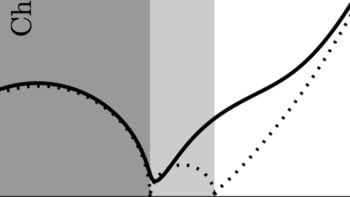
Electron–phonon interactions in a material have been modelled by combining billions of Feynman diagrams. Using a modified form of the Monte Carlo method, Marco Bernardi and colleagues at the California Institute of Technology predicted the behaviour of polarons in certain materials without racking up significant computational costs.
Phonons are quantized collective vibrations of the atoms or molecules in a lattice. When an electron moves through certain solids, it can interact with phonons. This electromagnetic interaction creates a particle-like excitation that comprises a propagating electron surrounded by a cloud of phonons. This quasiparticle excitation is called a polaron.
By lowering the electron’s mobility, while increasing its effective mass, polarons can have a substantial impact on the electronic properties of a variety of materials – including semiconductors and high-temperature superconductors.
However, physicists have struggled to model polarons and it would be extremely helpful for them to represent polarons using Feynman diagrams. These are a mainstay of particle physics, which are used to calculate the probabilities of certain particle interactions taking place. This has been challenging because polarons emerge from a superposition of infinitely many higher-order interactions between electrons and phonons. With each successive order, the complexity of these interactions steadily increases – along with the computational power required to represent them with Feynman diagrams.
Higher-order trouble
Unlike some other interactions, each higher order becomes more and more important in representing the polaron as accurately as possible. As a result, calculations cannot be simplified using standard perturbation theory – where only the first few orders of interaction are required to closely approximate the overall process.
“If you can calculate the lowest order, it’s very likely that you cannot do the second order, and the third order will just be impossible,” Bernardi explains. “The computational cost typically scales prohibitively with interaction order. There are too many diagrams to compute, and the higher-order diagrams are too computationally expensive. It’s basically a nightmare in terms of scaling.”
Bernardi’s team – which also included Yao Luo and Jinsoo Park – approached the problem with the Monte Carlo method. This involves taking repeated random samples within a space of all possible events contributing to a process, then adding them together. It allows researchers to build up a close approximation of the process, without accounting for every possibility.
The team generated a series of Feynman diagrams spanning the full range of possible electron–phonon interactions. Then, they combined the diagrams to gain precise descriptions of the dynamic and ground-state properties of polarons in real materials.
Statistical noise
One issue with a fully-random Monte Carlo approach is the sign problem, which arises from statistical noise that can emerge as electrons scatter between different energy bands during electron–phonon interactions. Since different bands can contribute positively or negatively to the interaction probabilities represented by Feynman diagrams, these contributions can cancel each other out when added together.

How Feynman diagrams transformed physics
To avoid this, Bernardi’s team adapted the Monte Carlo method to evaluate each band contribution in a structured, non-random way – preventing sign cancellations. In addition, the researchers applied a matrix compression approach. This vastly reduced the size and complexity of the electron–phonon interaction data, without sacrificing accuracy. Altogether, this enabled them to generate billions of diagrams without significant computational costs.
“The clever diagram sampling, sign problem removal, and electron–phonon matrix compression are the three key pieces of the puzzle that have enabled this paradigm shift in the polaron problem,” Bernardi explains.
The trio hopes that its technique will help us understand polaron behaviours. “The method we developed could also help study strong interactions between light and matter, or even provide the blueprint to efficiently add up Feynman diagrams in entirely different physical theories,” Bernardi says. In turn, it could help to provide deeper insights into a variety of effects where polarons contribute – including electrical transport, spectroscopy, and superconductivity.
The research is described in Nature Physics.



